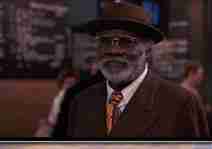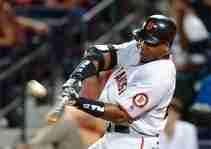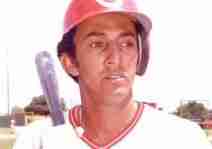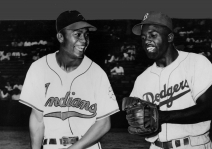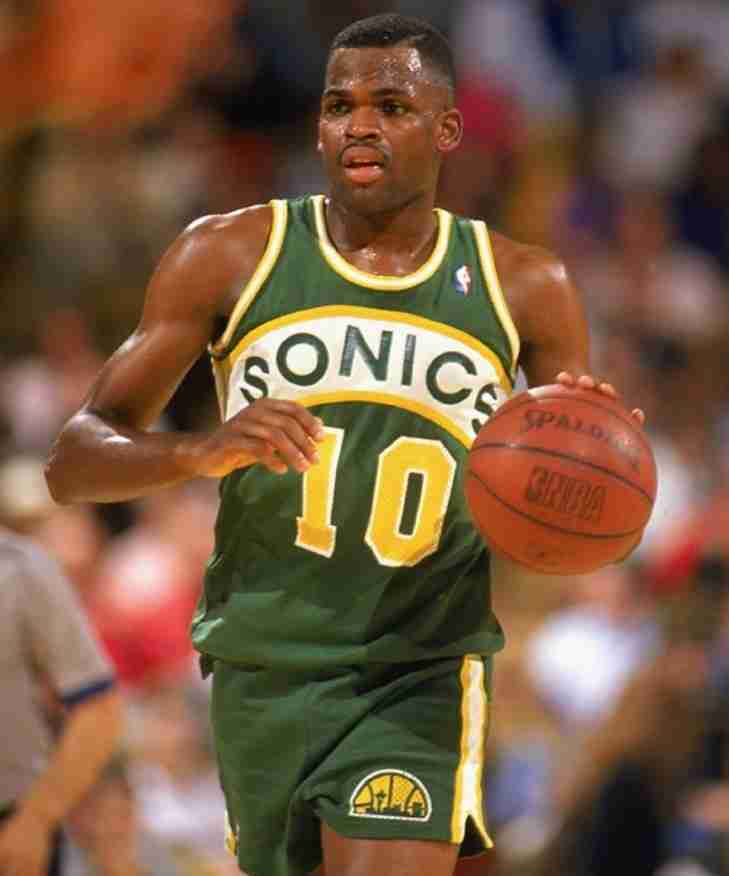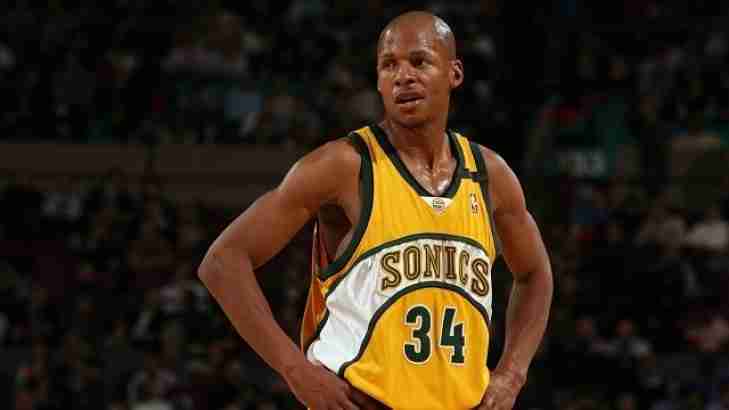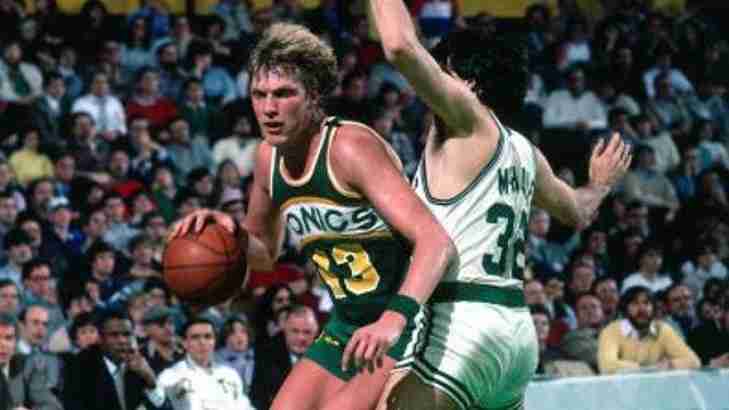Warning: Attempt to read property "params" on null in /home/notinhal/public_html/plugins/k2/k2canonical/k2canonical.php on line 382
24. Dick Snyder
Jan 21, 2017
Published in
Top 50 Oklahoma City Thunder
Dick Snyder would have the most productive years of his professional career as a member of the Seattle SuperSonics. Snyder would have three seasons where he had over 15 PPG and would later return to Seattle where he would off the bench help them to their only NBA Title. Not a bad way to end your professional career!
21. Dennis Johnson
Jan 21, 2017
Published in
Top 50 Oklahoma City Thunder
Dennis Johnson would take over the starting Shooting Guard role for the Seattle SuperSonics and the super-athletic Johnson would dazzle fans with his dunking and attention to defensive detail. Johnson was not just a huge factor in Seattle’s first NBA Championship; he was named the Finals MVP.
31. Lonnie Shelton
Jan 21, 2017
Published in
Top 50 Oklahoma City Thunder
Lonnie Shelton would lead the NBA in Personal Fouls in his first two years in the league when he was with the New York Knicks, but he had much more control in his third season, where he went to the Seattle SuperSonics and was the starting Power Forward for the 1979 NBA Championship Team. Shelton was very good defensively and would be named to a Second Team All Defensive roster in 1982, which was the same season that he would represent the Sonics in the All Star Game.
23. Sam Perkins
Jan 19, 2017
Published in
Top 50 Oklahoma City Thunder
“Big Smooth”, “Sleepy” Sam Perkins did not arrive to Seattle as the player he once was with Dallas and the Lakers but he was still a very efficient player and would evolve into an excellent bench player for the Sonics. He would provide a veteran presence to a very good Seattle front court and was a key contributor come playoff time.
26. Michael Cage
Jan 19, 2017
Published in
Top 50 Oklahoma City Thunder
Before we talk about the on the court accomplishments of Michael Cage, I absolutely love the fact that his two nicknames are “John Shaft” and the “Windexman”.
Seriously, it doesn’t get much cooler than that.
Seriously, it doesn’t get much cooler than that.
22. Derrick McKey
Jan 19, 2017
Published in
Top 50 Oklahoma City Thunder
Dubbed “Heavy D”, Small Forward, Derrick McKey was considered by many to be a consummate team player. A good defensive player, McKey would put together three straight seasons for the SuperSonics where he averaged over 15 Points per Game. The former SEC Player of the Year was a popular figure in Seattle and loved for his consistent game and while he would be named to a pair of Second Team All-Defensive squads with the Indiana Pacers it was with Seattle where he was at his best offensively.
18. Nick Collison
Jan 19, 2017
Published in
Top 50 Oklahoma City Thunder
You hear a lot about "glue guys" in the NBA and the players that may not be statistical beasts but have an intangible that makes a team want to keep them. Such a player was Nick Collison, who was a star at the University of Kansas but was a bench player with the Seattle SuperSonics/Oklahoma City Thunder for all fourteen (2004-05 to 2017-18) seasons in the NBA. Collison rotated between Power Forward and Center, where he helped them reach the 2012 Finals and always provided leadership and stability. While his overall averages of 20.2 Minutes, 5.9 Points and 5.2 Rebounds per Game may not seem impressive, there is a reason why his #4 was the first jersey retired after the team relocated to Oklahoma City.
12. Dale Ellis
Jan 18, 2017
Published in
Top 50 Oklahoma City Thunder
Seattle is a beautiful city, but for Dale Ellis it had to be a paradise after being traded there.
19. Brent Barry
Jan 18, 2017
Published in
Top 50 Oklahoma City Thunder
The son of Hall of Famer, Rick Barry, Brent Barry was one of the most accurate shooters during his time in Seattle. Known for his three pointer, Barry would never shoot below .400 from behind the arc, including one season (2000-01) where he led the NBA. Barry would also lead the Association twice in Effective Field Goal Percentage and once in True Shooting Percentage.
15. Nate McMillan
Jan 18, 2017
Published in
Top 50 Oklahoma City Thunder
A defensive minded Guard, Nate McMillan played all twelve of his seasons in the National Basketball Association with the SuperSonics. Five seasons, McMillan would average over 2 Steals per Game, including a 3.0 run in 1993/94 that would lead the league. Twice he would make Second Team Defensive honors. While McMillan was not known for his offense, he was a decent distributor and had solid Assists numbers throughout his career.
9. Spencer Haywood
Jan 18, 2017
Published in
Top 50 Oklahoma City Thunder
Spencer Haywood challenged the rules of the National Basketball Association by declaring himself eligible for the draft after his sophomore season in college. The NBA refused to allow him to play (as the rule at the time was that a player was not NBA eligible until the college class graduated) so he went to the upstart American Basketball Association and promptly won the league MVP as a rookie. As you can imagine, somebody from the NBA would covet a talent like this, which was occurred when Seattle signed him anyway and a lawsuit went all the way to Supreme Court. The NBA settled and the Sonics had a star.
16. Lenny Wilkens
Jan 18, 2017
Published in
Top 50 Oklahoma City Thunder
Inducted into the Naismith Basketball Hall of Fame as both a player and a coach, Lenny Wilkens was a player for Seattle for four seasons going to the All Star Game in three of them.
11. Ray Allen
Jan 17, 2017
Published in
Top 50 Oklahoma City Thunder
In every full season that Ray Allen spent with Seattle, he was named an All-Star. Known for his sweet shooting skill, Allen’s season average never dipped below 23 Points per Game (as a Sonic) and without question, he was considered the king of the three-point shot. Allen would later become part of a “big three” with Paul Pierce and Kevin Garnett and win a Championship in Boston but guaranteed there were many in Seattle cheering him on in his later accomplishments.
10. Detlef Schrempf
Jan 17, 2017
Published in
Top 50 Oklahoma City Thunder
The first German star of the National Basketball Association, Detlef Schrempf was already an All-Star (with Indiana) when he came to Seattle but it was in the state of Washington where he would become a national star. Schrempf was a part of the Sonics' push to the 1996 Finals and would make two more All-Star Games while playing for Seattle. Schrempf would post his best scoring season with 19.2 PPG (1994-95) as a Sonic.
6. Gus Williams
Jan 16, 2017
Published in
Top 50 Oklahoma City Thunder
Signing with Seattle as a Free Agent, Gus Williams became a top scorer in the NBA. Williams would watch his numbers climb in the first three years and would have likely saw an increase in the fourth season had he not sat out the entire campaign due to a contract dispute.
7. Rashard Lewis
Jan 16, 2017
Published in
Top 50 Oklahoma City Thunder
Drafted later than most pundits thought he would be (he was 32nd overall and the last waiting in the “green room”, Rashard Lewis would blossom into stardom with the SuperSonics. In the 2004-05 season, Lewis would make his first of two All Star Games (his second would be with the Orlando Magic) and rattle off three straight 20 Point per Game seasons. He remains one of the most prolific three point shooter in Sonics/Thunder history.
14. Fred Brown
Jan 15, 2017
Published in
Top 50 Oklahoma City Thunder
Known for his sweet outside shot, “Downtown” Freddie Brown was a productive Shooting Guard for thirteen seasons, all of which were with the Seattle SuperSonics. Brown would be one of the first true beneficiaries of the three point line as he was the first leader of three point percentage when the rule was instituted in the 1979-80 season. The season before, Brown (though coming off of the bench) captained the Sonics to their only NBA Title. He would average over 20 Points per Game twice and represented Seattle in the 1976 All Star Game.
4. Shawn Kemp
Jan 11, 2017
Published in
Top 50 Oklahoma City Thunder
Dubbed the “Reign Man” by the Seattle faithful, Shawn Kemp was best known for his many kids with multiple women as he was for his on the court skill.
5. Jack Sikma
Jan 11, 2017
Published in
Top 50 Oklahoma City Thunder
With your Center, you hope that he can give you a double-double on a somewhat regular basis. Sikma averaged that seven times as a SuperSonic all of which saw him go to the All Star Game.
3. Kevin Durant
Jan 11, 2017
Published in
Top 50 Oklahoma City Thunder
One more season in Oklahoma would have probably put Kevin Durant in the number one spot for the Sonics/Thunder list.


